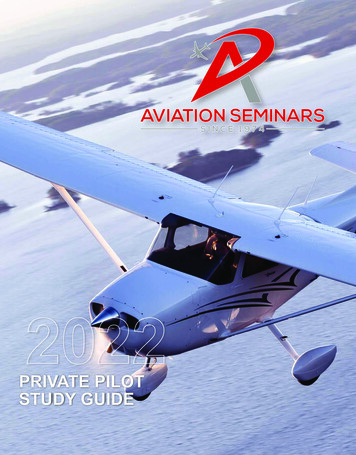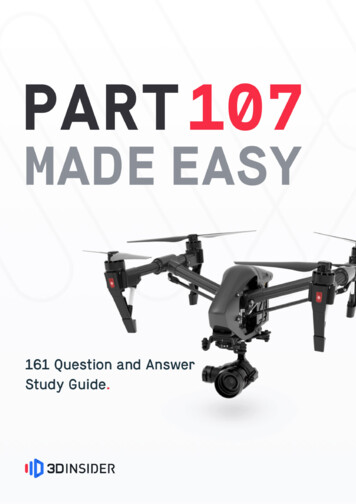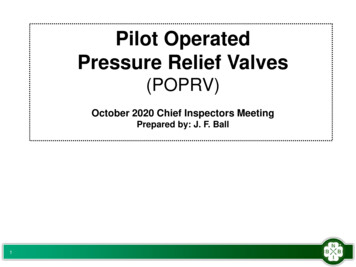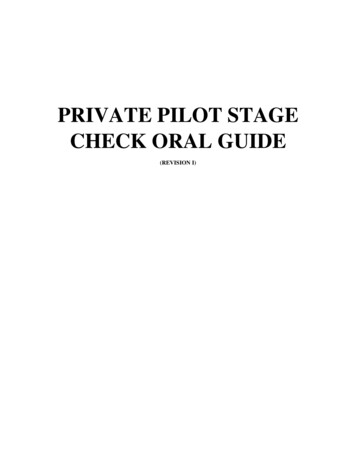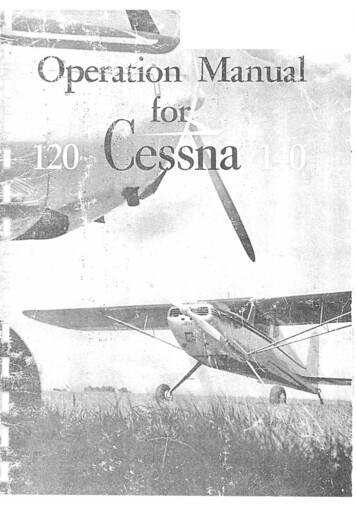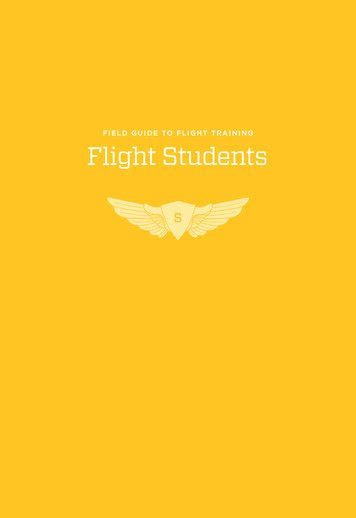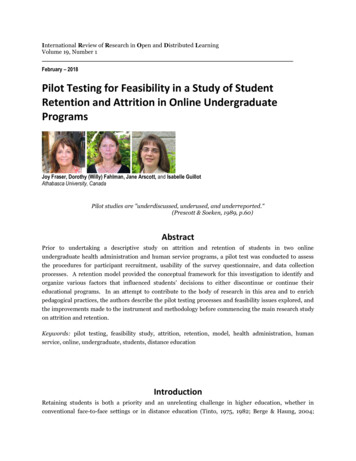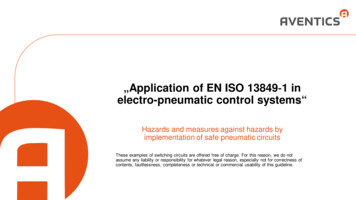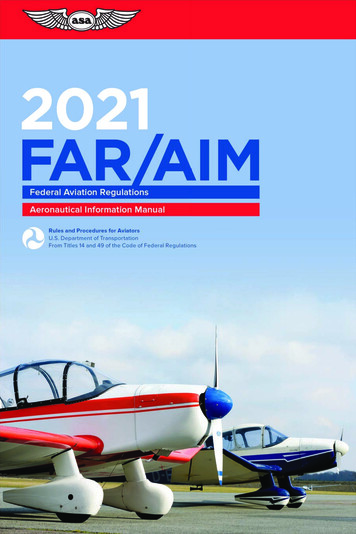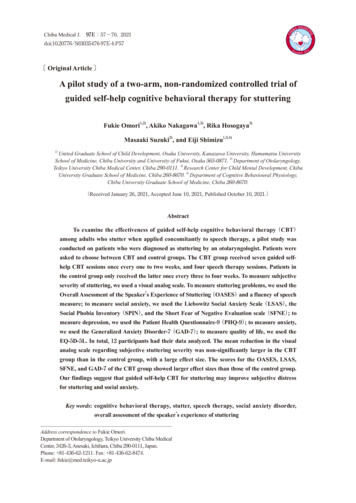
Transcription
Chiba Medical -P57〔 Original Article 〕A pilot study of a two-arm, non-randomized controlled trial ofguided self-help cognitive behavioral therapy for stutteringFukie Omori1,2), Akiko Nakagawa1,3), Rika Hosogaya2)Masaaki Suzuki2), and Eiji Shimizu1,3,4)1)United Graduate School of Child Development, Osaka University, Kanazawa University, Hamamatsu UniversitySchool of Medicine, Chiba University and University of Fukui, Osaka 565-0871 . 2 ) Department of Otolaryngology,Teikyo University Chiba Medical Center, Chiba 290-0111 . 3 ) Research Center for Child Mental Development, ChibaUniversity Graduate School of Medicine, Chiba 260-8670 . 4 ) Department of Cognitive Behavioural Physiology,Chiba University Graduate School of Medicine, Chiba 260-8670 .(Received January 26, 2021, Accepted June 10, 2021, Published October 10, 2021.)AbstractTo examine the effectiveness of guided self-help cognitive behavioral therapy(CBT)among adults who stutter when applied concomitantly to speech therapy, a pilot study wasconducted on patients who were diagnosed as stuttering by an otolaryngologist. Patients wereasked to choose between CBT and control groups. The CBT group received seven guided selfhelp CBT sessions once every one to two weeks, and four speech therapy sessions. Patients inthe control group only received the latter once every three to four weeks. To measure subjectiveseverity of stuttering, we used a visual analog scale. To measure stuttering problems, we used theOverall Assessment of the Speaker’s Experience of Stuttering(OASES)and a fluency of speechmeasure; to measure social anxiety, we used the Liebowitz Social Anxiety Scale(LSAS), theSocial Phobia Inventory(SPIN), and the Short Fear of Negative Evaluation scale(SFNE); tomeasure depression, we used the Patient Health Questionnaire-9(PHQ-9); to measure anxiety,we used the Generalized Anxiety Disorder-7(GAD-7); to measure quality of life, we used theEQ-5D-5L. In total, 12 participants had their data analyzed. The mean reduction in the visualanalog scale regarding subjective stuttering severity was non-significantly larger in the CBTgroup than in the control group, with a large effect size. The scores for the OASES, LSAS,SFNE, and GAD-7 of the CBT group showed larger effect sizes than those of the control group.Our findings suggest that guided self-help CBT for stuttering may improve subjective distressfor stuttering and social anxiety.Key words: cognitive behavioral therapy, stutter, speech therapy, social anxiety disorder,overall assessment of the speaker’s experience of stutteringAddress correspondence to Fukie Omori.Department of Otolaryngology, Teikyo University Chiba MedicalCenter, 3426-3, Anesaki, Ichihara, Chiba 290-0111, Japan.Phone: 81-436-62-1211. Fax: 81-436-62-8474.E-mail: fukie@med.teikyo-u.ac.jp
58Fukie Omori et al.Ⅰ.Introductionfactors that can be concomitantly found in the CALMSmodel. Conversely, a large cohort study that aimed toAccording to the DSM- 5[1], stuttering refersassess the social anxiety, stuttering severity, and speechto a childhood-onset fluency disorder. Symptoms ofdissatisfaction of adolescents who stutter showed thatstuttering include repetitions, prolongations of sounds,they also need cognitive, affective, and social supportaudible or silent blocking. Incidence rate approximately8 11% of infants worldwide[2,3].[16].Hence, we deemed that adults who stutter shouldHowell and Davis[4]have created a model to predictreceive CBT as well as speech therapy in their regularwhether eight-year old children will persist with theirtreatment. There were reports that the effect of CBT onstuttering or recover by the time they become teenagers.stuttering was examined by RCT[17,18]. Thirty adultsGenerally speaking, children who stutter are often teasedwith chronic stuttering were randomly allocated toand bullied by others[5], and these negative experiencesreceive either speech therapy following a CBT treatmentcan lead to mental health problems, includingfor social anxiety or speech therapy alone. The CBTdepression and social anxiety disorder(SAD)[6].treatment was associated with significant improvementsMoreover, such mental issues may be externalized byin psychological functioning but did not improvethe difficulty of talking in front of others due to feelingfluency; the participants’subjective evaluation wasextremely ashamed[7]. One study analyzed data fromnot examined in this study. Thirty-two adults seeking28 community surveys from the World Mental Healthtreatment for stuttering were randomly allocated toSurvey Initiative and included 142,405 respondents,receive either speech therapy following an online CBTaged 18 or older. This study found prevalence estimatesor speech therapy alone. The online CBT treatmentof SAD over 30-day, 12-month, and the lifetime areadded clinically significant improvement to quality of1.3, 2.4, and 4.0% across all countries[8]. Blumgart,life[17].Tran, and Craig[9]found that approximately 40% of theadults in their sample who stutter have SAD.Among the possible treatments for SAD, whichinclude selective serotonin reuptake inhibitors(SSRIs)The present pilot study aimed to examine theeffectiveness of guided self-help CBT among adultswho stutter and have SAD symptoms when it is appliedconcomitantly to speech therapy.[10], individual cognitive behavioral therapy(CBT)using the Clark and Wells model for SAD has beenⅡ.Methodsfound to be the most effective[11]. A previousrandomized controlled trial examined the effectivenessParticipantsof CBT for SAD among participants who remainThis study was conducted on patients who came tosymptomatic despite receiving treatment with SSRIs,our hospital complaining of stuttering symptoms at theand showed that the addition of CBT helped reduce theDepartment of Otolaryngology at Teikyo Universityseverity of participants’SAD and depressive symptomsChiba Medical Center. Inclusion criteria were beingand helped improve their functioning and quality of lifeaged 12-65 years; meeting the criteria of childhood-when compared to the control group[12,13].onset fluency disorder according to the DSM-5 afterTo help understand the maintenance of stutteringbehavior, the cognitive, affective, linguistic, motor, andbeing diagnosed with stuttering by an otolaryngologist;and providing written informed consent.social(CALMS)multi-dimensional model focuses onExclusion criteria were severe psychiatric disordersthese five mentioned components of the lives of adultssuch as severe schizophrenia spectrum disorders,who stutter[14]. Nonetheless, the main treatment forsevere bipolar disorder, increased risk of suicide whenchildren and adults who stutter remains speech therapyenrolling in the study, and substance abuse. Participants[15], which indeed improve the linguistic and motordiagnosed with common mental disorders(e.g., major
A pilot study of cognitive behavioral therapy for adults who stutterdepressive disorder and SAD)by the Mini-International59guided self-help CBT sessions.Neuropsychiatric Interview(MINI)[19,20]wereCBT consisted of 14 steps. Two to three steps wereeligible for inclusion. Participants could choose todone in one session. Participants’homework was toparticipate in the CBT or control groups. This pilot studyperform each step’s tasks before the next treatment daywas designed as a two-arm, non-randomized controlledand to read the next step’s corresponding workbooktrial and performed according to CONSORT guidelineschapter as preparation.[21].The study was approved by the Ethics Committeesof Teikyo University(Teirin17-167)and registered inThe CBT group also received four 20-minute speechtherapy sessions as usual care.the University Hospital Medical Information NetworkClinical Trials Registry(UMIN 000031916 ). Allparticipants provided written informed consent prior toOutcome measurementsOur primary clinical outcome measure was thevisual analog scale(VAS), which we used to assess theparticipation.subjective severity of stuttering. The VAS is one of themost widely used instruments in otolaryngology[24],InterventionRegarding usual care, the control group receivedmeasuring purely subjectively perceptible symptoms.20 -minute speech therapy sessions once every threeThe VAS indicated current stuttering severity on a 10-or four weeks for four months, for four total sessionscm straight line, where“0”is“normal”and“100”isof usual care. The first author, as a licensed speech“most severe.”therapist, provided the usual care sessions; the methodEight tools were used for the secondary evaluation.utilized was fluency shaping(e.g., learning aboutFirst, as all participants were Japanese, we used thearticulatory movements and practicing vowel productionJapanese version of the Overall Assessment of theby soft contact of articulators, short sentences, andSpeaker’s Experience of Stuttering(OASES)[25,26].words used in the workplace). Table 1 shows theThe tool comprises four subscales and 55 items: Sectionprotocol for the control group.I, general information(11 items); Section II, reactionsRegarding CBT treatment, the CBT group receivedto stuttering(15 items); Section III, communication in60-minute individual CBT sessions every one to twodaily situations(14 items); and Section IV, quality ofweeks. See Table 2 for the cognitive behavioral therapylife(15 items). Each item is scored on a scale from 1(CBT)group protocol.to 5. In section 1, 1 is“always”and 5 is“not at all.”Based on the Clark and Wells model[12,13]andIn Session 2, 1 is“I don’t feel at all”and 5 is“I alwaysusing a Japanese self-help workbook to treat SADfeel.”In Session 3, 1 is“not difficult at all”and 5 issymptoms[22], the first author, who had completed“extremely difficult.”A is the total score for each item,a CBT training course(Chiba Improving Accessand B is the number of valid responses times 5. Theto Psychological Therapies project: Chiba-IAPT;value of A / B x 100 is called the impact score. The[23])prior to this study and who received individualimpact score ranges between 20-100, and the scoressupervision by the last author, provided participants withof 20 . 0 - 29 . 9 , 30 . 0 - 44 . 9 , 45 . 0 - 59 . 9 , 60 . 0 - 74 . 9 , andTable 1Session No.Session 1Session 2Session 3Session 4Protocol for control groupContentsTimesSpeech therapyFirst timeSpeech therapySecond timeMidterm evaluation(intermediate)Speech therapyThird timeSpeech therapyFourth timeFinal evaluation(post)DetailsPatients learn about articulatory movements.Patients practice vowel production by soft contact of articulators.Patients practice short sentences.Patients practice vocabulary used in the workplace.
60Fukie Omori et al.Table 2Session No.ContentsProtocol for cognitive behavioral therapy(CBT)groupTimesStep 1Session 1CBTSpeech therapyStep 2First timeStep 3Session 2CBTStep 4Step 5Session 3CBTSpeech therapyStep 6Step 7Second timeStep 8Session 4CBTStep 9Step 10Step 11Session 5CBTStep 12DetailsCognitions related to social Patients formulate social situations, cognitions,anxietyanxiety, and physical reactions.Patients identify and drop dysfunctional safetySafety behaviorsbehaviors.Patients learn about articulatory movements.Patients learn how to shift self-focusedAttention-shift trainingattention flexibly to the outside.Behavioral and attentional Patients drop safety behaviors and shift theirchangesattention to the outside at the same time.Patients observe themselves objectively byVideo feedbackwatching self-taken video.Behavioral experiment 1Patients differentiate actual results frompredictedones through a real experiment.Behavioral experiment 2Patients practice vowel production by softcontact of articulators.Surveys about other people’s Patients balance their cognitions to conductthoughtssurveys of other people’s opinionsPatients learn how to stop ruminating andStopping repetitive thoughtsworrying before and after social situations.Imagery rescripting of memo- Patients rescript negative images and traumaticriesmemories of social situations.Patients learn to have a different perspective ofSchema worktheir schema-level beliefs.Patients relearn how to cope with stressfulRelapse preventionsocial situations from the previous CBT steps.Midterm evaluation(intermediate)Session 6CBTSpeech therapyCBTSession 7Speech therapyStep 13Assertive communicationStep 14Problem-solvingThird timeReview andsummarizingFourth timePatients learn how to use assertive communication.Patients learn six problem-solving steps toencourage solution-focused thinking.Patients practice short sentences.Patients review and summarize all CBTsessionsPatients practice vocabulary used in theworkplace.Final evaluation(post)75.0-100 represent mild, mild to moderate, moderate,the appearance rate of the core stuttering symptoms.moderate to severe, and severe impact of stuttering onSpeech fluency scores were: 0 to fewer than 3(normalquality of life, respectively.range), 3 to fewer than 5(very mild), 5 to fewer thanTo assess speech fluency, we used a tool developed12(mild), 12 to fewer than 37(moderate), and 37 toby Ozawa et al.[27]in which we asked participants tofewer than 71(severe). There is no upper limit to thisperform an audio-recorded three-minute speech. Thescore, and 71 or above is defined as the most severe.audio data were analyzed by the first author by countingTo assess the degree of social anxiety, we used thethe number of blocks, prolongations, and repetitions thatLiebowitz Social Anxiety Scale(LSAS)[28,29]. Thecould be considered stuttering, which was divided by thetool comprises 24 items. Each item is scored on a scaletotal number of uttered phrases times 100 to calculatefrom 0 to 3. Based on previous research, a score of 60
A pilot study of cognitive behavioral therapy for adults who stutter.or more indicates the participant had SAD[30]61and Mann-Whitney U test using IBM SPSS statistics 22To assess social phobia, we used the Japanese(IBM Corp., Armonk, NY, USA). Differences beforeversion of the Social Phobia Inventory(SPIN)[31],and after intervention in each group are compared usingwhich comprises 17 items. Scores range from 0(notpaired t-test and Wilcoxon signed rank test, and theapplicable at all)to 4(very true). Its cutoff point is 22results are shown in the text. Differences between theand above in Japanese clinical settings; the higher thetwo groups were compared using the unpaired t-test andscore, the more severe the social anxiety[32].the Mann-Whitney U test. Since the results were similar,To assess social anxiety of negative evaluations fromthe unpaired t-test results are shown in the table, andothers, we used the Japanese version of the Short Fearthe Mann-Whitney U test results are shown in the text.of Negative Evaluation scale(SFNE)[33,34]. The toolThe differences in the mean scores between time(precomprises 12 items. Each item is scored on a scale fromvs. intermediate vs. post)and group(CBT group vs.1(not applicable at all)to 5(very true). Higher scorescontrol group)were assessed using two-way analysisindicate stronger fear of negative ratings.of variance ANOVA(two-way ANOVA)with postTo assess depression, we used the Patient Healthhoc Bonferroni test. All P values were two-sided; a pQuestionnaire-9(PHQ-9)[35,36]. The tool comprisesvalue of .05 was considered statistically significant.nine items. Each item is scored on a scale from 0(notThe effect size was calculated using Cohen’s d[41],at all)to 3(almost every day). The scores correspondcalculated as the difference between both groups’meansto the following: 1-4 points(minor depression), 5-9divided by their pooled standard deviation; a value ofpoints(mild), 10-14 points(moderate), 15-19 points 0.20 was deemed a small effect, 0.50 a medium(moderate to severe), and 20-27 points(severe).effect, and 0.80 a large effect size.To assess generalized anxiety disorder, we used theGeneralized Anxiety Disorder- 7(GAD- 7 )[37,38].Ⅲ.ResultsThe tool comprises seven items. Each item is scoredon a scale from 0(not at all)to 3(almost every day).Scores are as follows: 5-9 points(mild), 10-14 points(moderate), and 15-21 points(severe).RecruitmentFigure 1 shows participants’flow diagram. In total,36 patients who stuttered visited the otolaryngologist inTo assess health-related quality of life, we used thethe relevant hospital during the study. Among these, 18EuroQol 5-dimension 5-levels(EQ-5D-5L)[39,40].were under 12 years old, and three patients declined toThe tool consists of five subscales(motion, personalparticipate; 21 patients were therefore excluded, whichcontrol, daily activities, pain/discomfort, anxiety/block)gave us a final sample of 15 participants.with the following response options(no problems;Among our final sample, 10 participants choseslight problems; moderate problems; severe problems;the CBT arm, and five chose the control. Nonetheless,extreme problems). The maximum quality of life valuein the CBT group, three participants discontinuedof 11111, which represents perfect health, is defined asparticipation during the study: one started working for1.000, and the minimum of 55555 is defined as -0.025.a new company after the first session; one started jobAll participants were evaluated at three time points:hunting after the second session; and we lost contactat the start of the interventions(week 0), in the middlewith one after the second session. Hence, their data wasof the interventions(during weeks 5-10), and in theexcluded from the analyses because they attended lowerfinal intervention(during weeks 7-14).than 30% of the seven CBT sessions. Finally, sevenCBT participants and five control participants whoStatistical analysesData analysis was performed through F-tests andt-tests(paired, unpaired)and Wilcoxon signed-rank testreceived more than 30% of the total CBT sessions hadtheir collected data analyzed.
62Fukie Omori et al.EnrollmentAssessed for eligibility (n 36)Excluded (n 21) ی ᴾ ᴾ Notmeeting inclusion criteria (n 18):Under 12 years old ی ᴾ ᴾ Declinedto participate (n 3)Nonrandomized (n 15)AllocationIntervention (n 10)Control (n 5)Cognitive behavioral therapy and speechSpeech therapyᴾtherapy.ᴾFollow-UpDiscontinued intervention after the 2nd sessionLost to follow-up (n 0)ᴾ ᴾ ᴾ ᴾ ᴾ ᴾowing to lost contact (n 1)Discontinued intervention (n 0)Discontinued intervention after the 1st sessiondue to working for a new company (n 1).Discontinued intervention after the 2nd sessiondue to job hunting (n 1).AnalysisAnalyzed (n 7)Excluded from analysis (n 3)ᴾ ᴾ ᴾbecause the percentage of attended sessionsAnalyzed (n 5)Excluded from analysis (n 0)ᴾwas lower than 30%Fig. 1 CONSORT 2010 flow diagram. Of the 36 patients diagnosed with stuttering, 18 children under 12 years of age and3 patients who did not consent to participate in the study were excluded. Fifteen people were asked to choose between the intervention(CBT)group and the control group. There were 10 patients in the intervention group and 5 patients in the control group. Duringfollow-up, 3 patients in the intervention group withdrew, and the results of 7 patients in the intervention group and 5 patients in thecontrol group were analyzed.Demographics and clinical characteristicsTable 3 summarizes participants’clinical characteristics at baseline.for the VAS, OASES, fluency of speech, LSAS, SPIN,PHQ- 9 , GAD- 7 , and EQ- 5 D- 5 L measures betweenthe two groups. The mean VAS scores at baselineIn terms of percentage, while 85.7% of the patientswere 57.6 in the CBT group and 53.2 in the control(six out of seven)in the CBT group had SAD, 60.0%group, meaning both the CBT and control groups wereof the patients(three out of five)in the control groupsubjectively similar in severity. For the OASES athad SAD.baseline, mean scores ranged between 67.7 and 71.8 inThere were no significant differences in the scoresboth groups, suggesting moderate to severe subjective
63A pilot study of cognitive behavioral therapy for adults who stutterTable 3Characteristics of participants at the baselineAge(years), mean(SD)Female n(%)Diagnosis n(%)Stuttering onlyStuttering, social anxiety disorderStuttering, social anxiety disorder, agoraphobia, bulimia nervosaStuttering, social anxiety disorder, agoraphobia, panic disorderStuttering, social anxiety disorder, agoraphobia, major depressive disorderStuttering, agoraphobiaStuttering, social anxiety disorder, agoraphobia, alcohol abuseStuttering, social anxiety disorder, agoraphobia, alcohol abuse, majordepressive disorderStuttering, agoraphobia, alcohol dependence, major depressive disorderTotal number of stuttering with social anxiety disorder(%)Medication n(%)No medicationSertralineParoxetine, AlprazolamEscitalopramEthyl LoflazepateInitial evaluation(pre)mean(SD)VASOASESFluency of speechLSASSPINSFNEPHQ-9GAD-7EQ-5D-5LP value(unpaired t-test)29.8(11.2)0.622(40.0)CBT(n 7) Control(n 0.370.840.880.010.270.890.52CBT: cognitive behavioral therapy; VAS: Visual analog scale; OASES: Overall Assessment of the Speaker’s Experience ofStuttering; LSAS: Liebowitz Social Anxiety Scale; SPIN: Social Phobia Inventory; SFNE: Short Fear of Negative Evaluationscale; PHQ-9: Patient Health Questionnaire-9; GAD-7: Generalized Anxiety Disorder-7; EQ-5D-5L: EuroQol 5-dimension5-leveldistress regarding stuttering behavior. For fluency ofaverage score at baseline was significantly higher in thespeech at baseline, mean scores ranged from 5 to fewerCBT group compared to the control group(p 0.01),than 12 in both groups, suggesting mild stuttering fromindicating that the CBT group was very anxious aboutthe observers’viewpoint. For LSAS at baseline, thenegative ratings from others.mean scores were 60 or more in both groups, suggestingthe presence of SAD symptoms. For the SPIN atbaseline, the mean scores were over 22 in both groups,also suggesting the presence of SAD symptoms.Primary outcomeFigure 2 shows the results for each evaluation. Thesolid line shows the CBT group and the dashed lineThe only scale with significant differences wasshows the mean and standard deviation of the controlthe SFNE, with an average score of 41.0 in the CBTgroup pre, intermediate, and post. The results of thegroup and 34.4 in the control group. This means that thetwo-way ANOVA showed that there was no interaction
64Fukie Omori et al.between time and group(F(2,9) 3.96, n.s.). Tablerespectively. The difference between groups was non-4 show the results of the primary outcome measure bysignificant(- 8.64; p 0.19), but the effect size wastime period and group. Regarding the VAS, the meanmedium(Cohen’s d 0.72).change in the final evaluation compared to the baselineRegarding fluency of speech, the mean change inevaluation was -16.14(95% CI[-39.08, 6.80])andthe final evaluation compared to the baseline evaluation 10.00(95% CI[-8.54, 28.54])for the CBT andwas 0.37(95% CI[-6.61, 7.36])and -1.50(95%control groups, respectively. The differences betweenCI[- 7 . 00 , 4 . 00 ])in the CBT and control groups,groups were non-significant, but the decrease wasrespectively. The difference between groups was non-greater in the CBT group(-26.14, p 0.06), and thesignificant( 1.87; p 0.63), and the effect size waseffect size was large(Cohen’s d 1.22). In addition, thesmall(Cohen’s d 0.29).results of difference between pre- and post- interventionRegarding the LSAS, the mean change in the finalin each group using the paired t-test were not significantevaluation compared to the baseline evaluation was(p 0.14 in the CBT group and p 0.21 in the control-13.71(95% CI[-41.44, 14.01])and 6.80(95%CIgroup). The Wilcoxon signed-rank test, treated VAS[- 11 . 83 , 25 . 43 ])in the CBT and control groups,as non-parametric data, also showed no significantrespectively. The difference between groups was non-differences(p 0.13 in the CBT group and p 0.14 insignificant,(- 20.51; p 0.19), but the effect size wasthe control group).large(Cohen’s d 0.82).Regarding the SPIN, the mean change in the finalSecondary outcomesevaluation compared to the baseline evaluation wasFigure 2 and Table 4 show participants’detail scores-9.29(95% CI[-24.79, 6.21])and -1.20(95% CIin the secondary outcome measures. The results of two-[- 17 . 30 , 14 . 90 ])in the CBT and control groups,way ANOVA were as follows. Regarding OASES,respectively. The difference between groups was non-there was no interaction between time and group(Fsignificant(- 8.09; p 0.39), but the effect size was( 2 , 9 ) 2 . 49 , n.s.). Regarding fluency of speech,medium(Cohen’s d 0.54).there was no interaction between time and group(FRegarding the SFNE score, the mean change in the(2,9) 0.37, n.s.). Regarding LSAS-J, there was nofinal evaluation compared to the baseline evaluationinteraction between time and group(F(2,9) 1.07,was -5.14(95% CI[-10.93, 0.64])in the CBT groupn.s.). Regarding SPIN, there was no interaction betweenand 3 . 60( 95 % CI[ 0 . 61 , 6 . 59 ])in the controltime and group(F( 2 , 9 ) 0 . 42 , n.s.). Regardinggroup. The improvement in SFNE in the CBT groupSFNE, there was an significant interaction betweenwas significantly larger than that in the control grouptime and group(F(2,9) 5.35, p 0.03.), and post-(difference between two groups -8.74; unpaired t test,hoc Bonferroni test showed a significant deteriorationp .01, Mann-Whitney U-test: p .05), and the effectbetween the intermediate and post evaluations in thesize was large(Cohen’s d 1.70).control group(p 0 . 04 ). Regarding PHQ- 9 , thereThe SFNE score in the control group showedwas no interaction between time and group(F(2,9) a significant deterioration between pre- and post-0.20, n.s.). Regarding GAD-7, there was no interactionintervention using the paired t-test(p 0 . 03 ). Thisbetween time and group(F( 2 , 9 ) 2 . 91 , n.s.).result was also significant in the Wilcoxon signed rankRegarding EQ5D5L, there was no interaction betweentest(p 0 . 04 ). The SFNE score in the CBT grouptime and group(F(2,9) 0.30, n.s.).showed a non-significant change between pre- and post-Regarding the OASES, the mean change in theintervention using the paired t-test(p 0 . 07 ). Thisfinal evaluation compared to the baseline evaluationresult was not significant in the Wilcoxon signed rankwas -11.12(95% CI[-24.80, 2.56])and -2.48(95%test(p 0.06).CI[- 9 . 02 , 4 . 06 ])in the CBT and control groups,The mean SFNE score in the CBT group was
65A pilot study of cognitive behavioral therapy for adults who stutterOASES(ponit)VAS(mm)㔜 ᗘ㼂㻭 �㼍 �㼠㼑㼞㼙㼑㼐㼕㼍 ��㻚㻢60㻠㻠㻚㻡㻠㻡㻚㻝㻟㻥㻚㻞50 �ᡤ䛜 �㻽㻙㻥 �㼛㼘㻌㼓㼞㻟㻞㻚㻢LSAS(point)Fluency of 㼑㼞㼙㼑㼐㼕㼍 �㼓㼞㼛㼡㼜0.90.70.5preintermediatepostFig. 2 Graphs showing outcomes at each assessment. CBT: cognitive behavioral therapy; VAS: Visual analog scale;OASES: Overall Assessment of the Speaker’s Experience of Stuttering; LSAS: Liebowitz Social Anxiety Scale; SPIN:Social Phobia Inventory; SFNE: Short Fear of Negative Evaluation scale; PHQ-9: Patient Health Questionnaire-9; GAD-7:Generalized Anxiety Disorder-7; EQ-5D-5L: EuroQol 5-dimension 5-level. This is the result of the mean standard deviationof the intervention group(CBT group)and control group(control group)at the baseline(pre), intermediate evaluation(intermediate), and final evaluation(post)of the primary and secondary evaluations. CBT group is a red straight line, controlgroup is a black dashed line, is the mean value, and shadows are standard deviation.
66Fukie Omori et al.Table 4Changes from baselinePrimary outcomeVASSecondary outcomesOASESFluency of speechLSASSPINSFNEPHQ-9GAD-7EQ-5D-5LCBT(n 7)95%CIChanges in outcomesControl(n 5)95% ffect size(d)-16.14-39.08 to 6.8010.00-8.54 to -5.140.101-24.80 to 2.56-6.61 to 7.36-41.44 to 14.01-24.79 to 6.21-10.93 to 0.64-11.46 to 5.74-11.80 to 1.51-0.04 to 0.24-2.48-1.506.80-1.203.60-2.801.200.064-9.02 to 4.06-7.00 to 4.00-11.83 to 25.43-17.30 to 14.900.61 to 6.59-13.17 to 7.57-4.31 to 6.71-0.08 to 0.650.27CBT: cognitive behavioral therapy; VAS: Visual analog scale; OASES: Overall Assessment of the Speaker’s Experience ofStuttering; LSAS: Liebowitz Social Anxiety Scale; SPIN: Social Phobia Inventory; SFNE: Short Fear of Negative Evaluationscale; PHQ-9: Patient Health Questionnaire-9; GAD-7: Generalized Anxiety Disorder-7; EQ-5D-5L: EuroQol 5-dimension5-levelsignificantly higher than that in the control group usingwas 0 . 101( 95 % CI[- 0 . 04 , 0 . 24 ])and 0 . 064the unpaired t-test at the baseline(pre)(p 0.01). On(95%CI[-0.08, 0.21])in the CBT and control groups,the contrary, the mean SFNE score in the CBT grouprespectively. The difference between groups was non-was significantly lower than that in the control groupsignificant( 0.037; p 0.65), and the effect size wasusing the unpaired t-test at the final evaluation(post)small(Cohen’s d 0.27).(p 0.01). The results using the Mann-Whitney U test,Table 5 shows changes in the OASES subscales.treated SFNE as non-parametric data, also showed aRegarding the total impact score, the average chang
Table 2 Protocol for cognitive behavioral therapy( CBT) group Session No. Contents Times Details Session 1 CBT Step 1 Cognitions related to social anxiety Patients formulate social situations, cognitions, anxiety, and physical reactions. Step 2 Safety behaviors P
